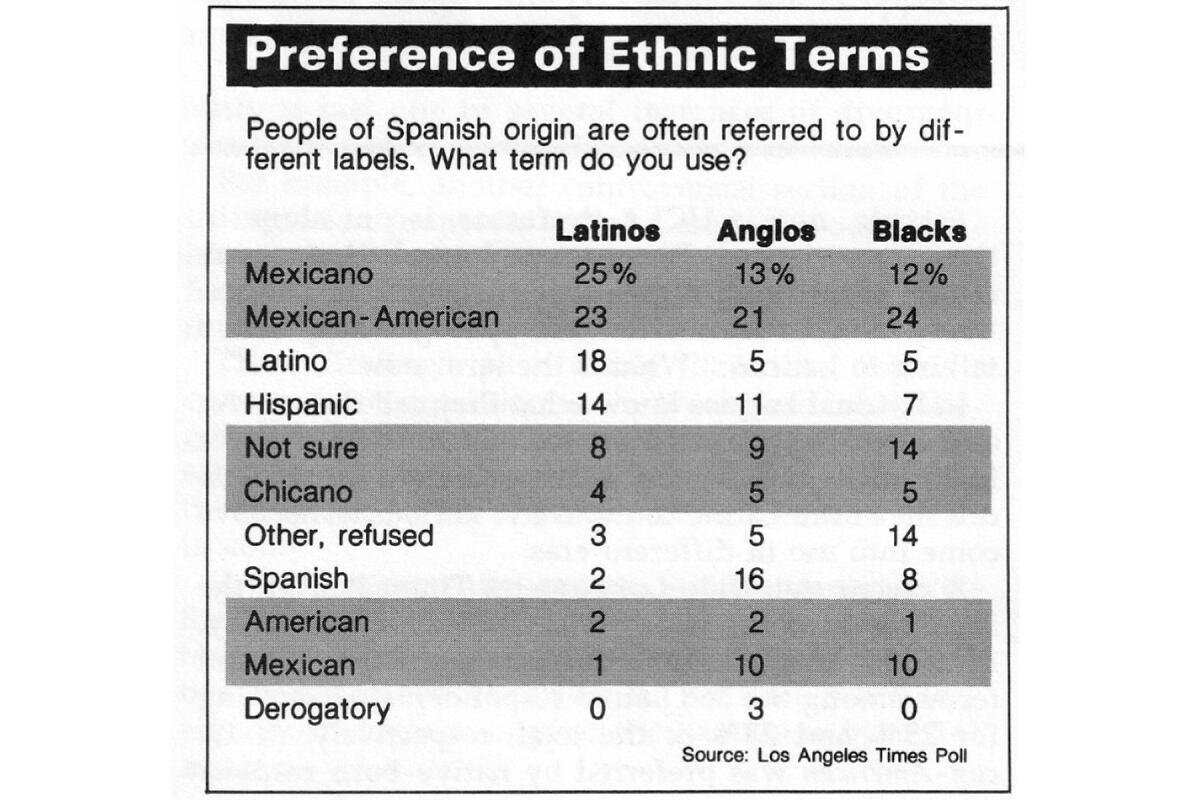Latinx Files: The story behind the name, and why Latinx voters are exhausted

- Share via
Hello and welcome to the first edition of the Latinx Files, the Los Angeles Times’ new newsletter about the Latinx experience.
I’m Fidel Martinez, an editor on The Times’ audience engagement team for the last three years. I’m a native of the magical borderlands of the Rio Grande Valley (puro 956 cuh!), a child of Mexican immigrants and, much to my dismay, a die-hard Dallas Cowboys fan.
Before joining The Times, I spent the bulk of my professional career at various media outlets geared toward an English-speaking Latinx audience: I was the politics editor for Mitú, worked in various editorial roles at Fusion and even wrote for a Latinx blog that no longer exists online (RIP Guanabee).
I tell you this because I believe now as I did then that there is a great need and desire for a space where Latinx stories are told, one in which our experiences and perspectives are centered. It’s a belief that I’ve built my career on.
You know who else agrees with this? My bosses. They’ve seen the numbers. They understand that for The Times to have a future, we need more Latinx readers. Like, a lot. Latinx people make up nearly half of L.A. County’s population, about 40% of the state of California and nearly a fifth of this country. Our current and past subscriber base is nowhere near close to those numbers, and as a result our reporting has historically reflected the whiteness of our audience, often to the detriment of the Latinx community.
The Latinx experience chronicled
Get the Latinx Files newsletter for stories that capture the multitudes within our communities.
You may occasionally receive promotional content from the Los Angeles Times.
Our very own Executive Editor Norman Pearlstine acknowledged as much in a staff memo this year.
“This publication fomented the hysteria that led to Japanese American incarceration, the Zoot Suit Riots, redlining and racial covenants, and it turned a blind eye to generations of police abuses against minority communities,” Pearlstine said. “At its worst, our coverage didn’t simply ignore people of color — it actively dehumanized them.”
Straight up, we need you more than you need us. And if we’re going to get the L.A. story right, and the California story right and the story of America right, we need to be getting Latinx stories right.
Which brings me to the purpose of the Latinx Files. First and foremost, I want to make clear that this space is yours. From the onset, the plan has been to rely on the audience for the types of stories that will populate the newsletter.
Thankfully, many of you had plenty of great ideas — from sharing Latinx academics’ new research to helping readers brush up on rusty Spanish to shining a light on L.A.’s South American communities.
All of these are fantastic suggestions! I will aim to cover as many as I can, and any more you send my way. I can’t stress this enough: Keep telling me what you want to read or see featured here. This newsletter belongs to you. You can find me on Twitter at @fidmart85 or email me at [email protected].
Consider subscribing to the Los Angeles Times
Your support helps us deliver the news that matters most. Become a subscriber.
So why use the term Latinx?
To me, the term “Latinx” is also a nod to what’s to come, to where we’re going.
It’s about being inclusive. When I say that I want this newsletter to be a space for everyone, I mean everyone. That includes people who don’t identify as male or female, who don’t see gender as binary.
I’m not saying that “Latinx” is what you should call yourself or that it should replace “Hispanic” or “Latina” or, in my case, “Tejano.” I don’t even care if you use it.
I have heard and read many of the criticisms of the term, and I understand them.
The term Latinx is controversial within the larger Latino community. So why did we use that term for our new newsletter?
But here’s the thing: Language is ever-evolving. This is true for how we as a community have described ourselves and how The Times’ own style has changed over time.
Take “Hispanic.” According to a recent Pew report, 61% of those people surveyed said they preferred that word to describe the larger community; only 29% went with “Latino/Latina.”
Given those numbers, you would think the term has been around forever. It hasn’t. Its rise in popularity dates to 1975, and it didn’t always enjoy the same broad acceptance it does today. In 1983, only 14% of Californians with Latin American ancestry polled by The Times said that it was their preferred term for self-identification.

Despite the seeming current popularity of “Hispanic,” the Los Angeles Times style guide gives preference to “Latino,” thanks in large part to the late, great Frank del Olmo, the first Latino (that’s what he preferred) to be listed on the newspaper’s masthead.
And as far as I know, that will remain The Times’ policy — except in this space, when I’m writing.
You can read more about why and how we’re using “Latinx” in my story over here. The back story involves soccer.
About those Latinx votes in Texas and Florida
“You’re not from here, you don’t know us.”
That’s what Kristian Limas, a 31-year-old self-identified leftist in McAllen, Texas, told me when I asked him what it was like watching armchair experts on Twitter and on cable news blame the Rio Grande Valley and its overwhelmingly Mexican American population on election night when it appeared that President Trump could be headed toward reelection.
Limas took exception to a community of more than 1.3 million being told how to vote by outsiders, or by white liberals who know about the RGV only because of the children in cages. It didn’t matter that Hidalgo, Starr, Cameron and Willacy counties — which together make up the region known as “the Valley” — all went to Joe Biden, albeit by slimmer margins than Hillary Clinton had won them by in 2016.
Limas, who voted for Biden after supporting Sen. Bernie Sanders in the primary, compared the punditry to being in a room where people are talking about you and pretending you’re not there. He finds it exhausting.
That Mexican Americans in South Texas and Cuban Americans in Miami, who received the larger share of the scrutiny that night, didn’t monolithically vote for Biden shouldn’t be a surprise to anyone.
It wasn’t to Times columnist Gustavo Arellano. “If ever there was a group that needed a stone-cold reckoning with us, it’s them,” Gustavo wrote of the Democratic establishment in his postelection column. “This is an ossified institution that continuously banks on Latinos running to it for protection from the mean GOP, then does little to keep us.”
And it certainly wasn’t news to Chuck Rocha, a former Sanders advisor who spoke to my colleague Brittny Mejia for her story about how Latinx voters were tired of being taken for granted by Democrats. “If I have to hear one more … white person on TV talk about our community not being a monolith,” he said. It “was like the Latino community was listening this whole time and being, ‘Let me just show you how much we are not a monolith.’”
There’s that exhaustion again.
My colleague Mariel Garza felt it too, and wrote about it in our Opinion section. “Really, we have to go through this again, explaining that Latinos are a racially, culturally, socioeconomically diverse group of people with a wide range of hopes and dreams and political leanings and not a uniform voting bloc?”
With that fatigue comes frustration that Latinx voters continue to be pigeonholed.
For Alex Fumero, a 37-year-old Cuban American film producer based in Los Angeles with roots in Miami, white people pointing fingers at Latinx voters reeked of hypocrisy, given how overwhelmingly white Trump’s base of support is.
Arielle Castillo, a social media strategist and Miami native, agreed. “Ohio voted for Trump, but no one is blaming John Kasich for that,” she said.
Both expressed concern that Biden’s victory would gloss over the perpetual erasure of Latinx communities.
For Michelle Serrano, a native of Brownsville, Texas, and communications strategist for the nonpartisan Rio Grande Valley Equal Voice Network, it only confirmed what she already suspected: Her community is on its own. “The only harm that came from Biden winning is [Democrats] saying that we didn’t exist. But that doesn’t mean that we’re going anywhere.”
Kween Beatrix, a dragtivist and resident of Brownsville, agreed.
“What people forget is that when we talk about the organizers in the Rio Grande Valley, they are some of the most badass, radical, hardcore people that you’ll ever meet,” she said. “For me, that’s where I hold my faith, in the people on the ground doing the work.”
The best thing on the Latinternet this week: election corridos

In Mexican and Mexican American culture, the corrido serves as a musical document that chronicles historical events. If something big happened, chances are there’s a corrido for that. The 2020 presidential election is no exception.
My personal favorite, however, is this cover of “La Chona” by Los Tucanes de Tijuana with alternate lyrics. It makes me think of summer days and nights spent at Dodger Stadium, where organist Dieter Ruehle would blast it through the PA system.
A special shoutout to my colleague Vanessa Martinez for flagging these videos for us!
Did you come across something amazing on the Latinternet that you think would be great for this section? Let me know at @fidmart85 or email me at [email protected].
The Latinx experience chronicled
Get the Latinx Files newsletter for stories that capture the multitudes within our communities.
You may occasionally receive promotional content from the Los Angeles Times.





